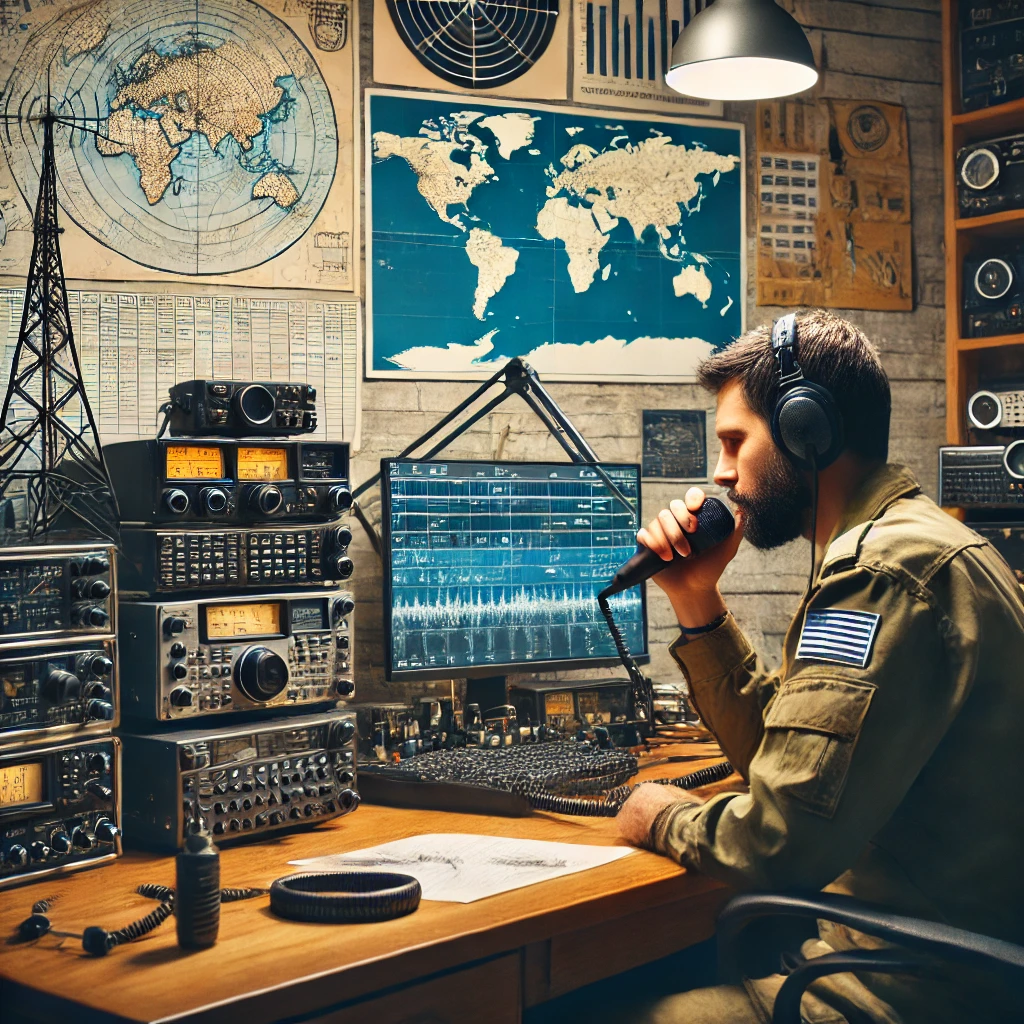Ham radio is a fascinating hobby that combines communication and technology, allowing enthusiasts to connect with others around the world. Whether new to the hobby or an experienced operator, there’s always room for improvement and new skills to learn.

Improving your ham radio skills can enhance your enjoyment and efficiency in communicating with others. This article offers practical tips and techniques designed to help you become a more proficient and confident ham radio operator.
1) Join a Local Radio Club

Joining a local radio club can significantly enhance your ham radio skills. These clubs provide a community of experienced operators who are eager to share their knowledge.
Local radio clubs often sponsor classes and workshops. These events help both beginners and seasoned operators improve their technical skills.
Many clubs offer mentoring for new hams. Experienced members can guide you through operating procedures and equipment setup. This one-on-one support can be invaluable.
Radio clubs also conduct licensing sessions. Getting licensed is a crucial step for any ham radio operator. Attending these sessions can help you pass the necessary exams.
Club meetings are a great place for networking. You can connect with individuals who have similar interests and learn about new trends in radio communication.
Some clubs participate in local events, providing communications support. This is a great way to gain practical experience and contribute to community efforts.
In times of emergency, radio clubs often play a vital role. They provide emergency response support and disaster relief communications. This can be a significant way to practice and apply your skills.
You can find local clubs through an online search or by visiting local radio stores. These sources usually have information about clubs in your area. Joining a local radio club can be one of the best ways to enhance your ham radio proficiency.
2) Learn Morse Code
Learning Morse code is a valuable skill for any ham radio operator. Morse code, also known as CW (Continuous Wave), enables clear and efficient communication, even in poor signal conditions.
To get started, it is important to learn the basic alphabet and numbers. The Ham Whisperer’s Morse Code Course can help by offering lessons that cover the entire International Morse Code.
Practice is crucial. One effective method is the Koch Method, where learners start with a small set of characters and gradually add more. Tools like the Morse Mentor app provide structured practice using this method.
Consistent practice helps improve speed and accuracy. Setting aside a few minutes each day to practice can lead to steady improvement. It’s also helpful to join clubs or groups such as the First Class CW Operators’ Club where experienced operators can provide guidance and support.
Using different tools can make learning more engaging. Games like Morse Mania turn practice into an enjoyable challenge, helping learners advance through various levels.
Recording and listening to your own sending can also help identify areas for improvement. Pay attention to timing and enunciation to minimize errors. Practicing regularly and seeking feedback from experienced operators can greatly enhance proficiency.
3) Upgrade Your License
Upgrading your ham radio license can greatly enhance your skills. Those holding a Technician Class license should consider moving up to a General Class license. A General Class license grants access to more frequencies and operating modes.
To upgrade to a General Class license, one must pass a written exam focusing on technical skills and regulations. The exam covers more advanced topics compared to the Technician Class exam.
Many resources are available to help study for the exam, including books, online courses, practice exams, and videos. Investing 30-40 hours of study can prepare most people for the test, according to the Ham Radio Study Guide.
Upgrading your license also benefits you in emergency communications. It provides new skills and capabilities, making you a more valuable team member. Learn more about how it can enhance your involvement by visiting the ARRL.
Taking the step to upgrade your license means gaining extensive HF privileges. This will allow you to communicate over longer distances and explore new operating modes, expanding the scope of your ham radio experience.
By investing the time and effort to upgrade, you will broaden your knowledge and improve your overall ham radio skills.
4) Utilize Digital Modes
Digital modes in ham radio open up a world of possibilities. These modes convert voice or data into digital signals, allowing for clearer and more efficient communication.
One popular digital mode is FT8. It uses an 8-frequency shift keying format. FT8 is excellent for making contacts even when signals are weak.
PSK31 is another useful digital mode. It’s known for its narrow bandwidth and efficient use of low power. This mode is great for casual text conversations.
RTTY (Radio Teletype) is an older but still effective digital mode. It’s often used for bulletin transmissions and keyboard-to-keyboard chatting.
Using digital modes can also help get more out of your ham radio setup. With proper software and a computer, you can easily start working with these modes. Digital modes also allow for automated communication, making it easier to log contacts and participate in global networks.
By integrating digital modes into ham radio practices, operators can improve their skills and expand their communication capabilities.
5) Participate in Contests
Participating in ham radio contests can greatly enhance skills. These competitions push operators to make as many contacts as possible within a set time.
Contests help operators improve their communication techniques. They learn to copy messages accurately and recognize faint signals better. This is especially useful in real-world situations where conditions may not be perfect.
Ham radio contests promote portable communication by encouraging operators to set up mobile or temporary stations. This can be valuable in emergencies when traditional communications might fail. Contesting also improves knowledge of signal propagation.
Another benefit is the opportunity to network with other enthusiasts. By participating in contests, operators can connect with more experienced hams and learn from their strategies and approaches.
Beginners can start by listening to how others operate during contests. This helps them understand different contesting styles and operating procedures. Over time, they can gain the confidence to make their own contacts and set personal records.
For more information on contesting, check out the Ham Radio Contests page. To learn about specific strategies and tips, visit Contesting in Ham Radio. Participating in contests is a fun and educational way to improve ham radio skills.
6) DIY Antenna Building
Building your own antenna is a great way to improve your ham radio skills. It allows operators to understand how antennas work and tailor them to specific needs. DIY antenna projects can save money and offer a hands-on learning experience.
One popular DIY project is the end-fed half-wave (EFHW) antenna. EFHW antennas are known for their simplicity and efficiency. Materials include wire, a transformer, and an insulator.
Another easy option is the dipole antenna. Dipoles are widely used and straightforward to construct. Using speaker wire, you can create 20M and 40M dipoles.
For beginners, a quarter-wave ground-plane antenna is an excellent choice. It is particularly effective for the 2m band. These antennas are simple to build and perform better than many handheld antennas.
Building antennas not only improves your technical skills but also enhances your radio’s performance. Simple antennas like wire antennas have been used for decades and continue to be effective.
Projects like these are beneficial for both novice and experienced hams. They offer a practical understanding of antenna design and improve one’s ability to troubleshoot and optimize setups. Whether it’s a basic wire antenna or a more complex build, DIY projects help sharpen your ham radio skills.
7) Attend Hamfests
Hamfests are a fantastic opportunity for ham radio enthusiasts to connect with others. These events often feature workshops and seminars on various amateur radio topics. Participants can learn about operating techniques, digital modes, emergency communication, and antenna design. This is a great way to expand knowledge and make friends in the community.
For those new to ham radio, attending a hamfest with an experienced friend can be very helpful. Seasoned hams can give advice on buying your first radio or picking the right antenna. It’s a chance to learn and get practical tips on improving your setup.
Hamfests also provide a marketplace for radio essentials. Visitors can find coax connectors, feedline, antenna supplies, and grounding rods. Finding these items in one place makes it easier to complete a station setup or upgrade existing equipment.
Networking is another key benefit of hamfests. Meeting experts and enthusiasts can lead to valuable friendships and mentorships. You can talk to people who share your passion and get answers to your questions directly from experts. This hands-on experience can enhance your skills significantly.
Events are often listed in resources like the ARRL Hamfests and Conventions Calendar. Planning ahead will ensure you don’t miss these enriching opportunities.
8) Read Technical Manuals
Reading technical manuals is crucial for any ham radio operator. Manuals provide detailed information on how to use and maintain various equipment. This can help you understand the capabilities and limitations of your devices.
Technical manuals often include troubleshooting sections. These can be extremely useful when something goes wrong. By referring to the manual, you can often fix issues without needing additional help.
Books such as the ARRL Handbook for Radio Communications are comprehensive guides. They cover everything from the basics of radio theory to advanced operating procedures. Such resources are invaluable for both beginners and experienced operators.
Investing time in reading manuals can enhance your technical skills. You’ll be better equipped to handle complex situations. Manuals can also offer insights into optimizing equipment performance.
Using high-quality transceivers and antennas can improve your transmission and reception. Understanding these devices through their manuals ensures efficient operation. It also helps in making informed decisions about upgrading or maintaining your station.
Technical manuals are not just for solving problems. They also provide guidelines for best practices. This helps in maintaining a smoothly running ham radio station. Reading these materials regularly keeps your knowledge fresh and up-to-date.
9) Experiment with Satellite Communications
Satellite communications offer ham radio operators a chance to connect across vast distances. Unlike traditional methods, satellites act as repeaters in space, making long-range contacts possible even with low power.
Amateur radio satellites have been around since the launch of OSCAR 1 in 1961. Since then, many more have been launched, each providing unique opportunities for experimentation.
Learning to track satellites is essential. Modern software tools simplify this by providing real-time position data. Many programs are available for free or purchase, making tracking straightforward.
Understanding Doppler shift is crucial when working with satellites. As satellites move, the frequency of their signals changes. Adjusting the radio to account for this ensures clear communication.
It’s also important to know when a satellite will be in range. Websites and applications offer schedules of satellite passes. With this information, operators can plan their sessions effectively.
Experimenting with different modes of communication, like voice, CW (Morse code), or digital, can expand an operator’s skill set. Some satellites support multiple modes, providing versatility.
Joining a community of satellite enthusiasts can offer support and advice. Many operators share tips, techniques, and experiences, making it easier to overcome challenges.
Experimenting with satellite communications not only enhances technical skills but also opens up a world of new contacts and experiences. To learn more about ham radio satellite communication and techniques, check out available resources and communities.
Understanding Ham Radio Fundamentals
Grasping the basics of ham radio involves knowing its key components and how signals travel. This foundation will enhance your ability to operate and troubleshoot your radio efficiently.
Basic Components and Functions
Ham radio uses several key parts to function. Transmitters send out radio signals. Receivers pick them up. The antenna is vital. It converts electrical signals to radio waves and vice versa. Power supplies provide the necessary energy.
Microphones and speakers are also crucial. The microphone lets users speak into the system, converting voice to electronic signals. The speaker turns these signals back into sound.
Transceivers combine transmitter and receiver functions into one unit. This dual-purpose component is common in ham radios. Tuning knobs help in selecting frequencies. Understanding these components and their roles will help users optimize their radio communication.
Signal Propagation
Signal propagation is how radio waves travel from one point to another. VHF and UHF bands are popular. They are effective for short-distance communication. These bands typically require a clear line of sight.
HF bands can travel longer distances. They bounce off the ionosphere, enabling communication over thousands of miles. This reflection ability makes them ideal for global contacts.
Environmental factors also affect signal propagation. Time of day, weather, and solar activity play roles. For instance, HF signals are stronger at night. VHF/UHF signals perform best during clear weather.
Antennas and their positioning impact signal strength. Placing antennas high up and clear of obstructions improves performance. Understanding propagation helps in selecting the right bands and times for effective communication.
Enhancing Communication Skills
Improving ham radio communication skills involves adopting effective operating procedures and mastering Morse Code. These skills help in transmitting and receiving messages more efficiently and clearly.
Effective Operating Procedures
Effective operating procedures are vital for clear and efficient communication. Using proper call signs and listening before transmitting ensures the frequency is clear. Operators should keep messages concise and focused, avoiding unnecessary information. Use of standard abbreviations and phonetic alphabets can also enhance message clarity.
Recording and logging communications helps keep track of contacts and frequencies used, aiding in organization and follow-up. Avoid jargon that might confuse others, and always be courteous and patient. By following these practices, operators reduce misunderstandings and improve overall communication success.
Mastering Morse Code
Morse Code remains an essential skill for many ham radio operators. It uses a series of dots and dashes to represent letters and numbers, allowing for communication even under poor signal conditions. Learning Morse Code involves memorizing the patterns and practicing regularly to increase speed and accuracy.
Using software or online platforms can aid in practice, providing instant feedback and varied exercises. Consistent practice with other operators helps in applying the skill in real-world scenarios. Mastery of Morse Code enables communication when voice signals fail, and it’s particularly useful in emergency situations, enhancing an operator’s versatility.
Advanced Techniques and Practices
Improving ham radio skills involves mastering antenna optimization and utilizing digital modes. These techniques can greatly enhance both transmission and reception quality.
Antenna Optimization
Antenna optimization is crucial for efficient ham radio operations. To begin, operators need to ensure their antennas are correctly tuned to their desired frequency bands. This can be achieved using an antenna tuner. Proper tuning reduces SWR (Standing Wave Ratio), leading to more efficient signal transmission.
Placement also plays a significant role. Antennas should be installed in high, unobstructed locations, away from buildings or trees. This helps minimize interference and maximizes signal reach. Rotatable directional antennas allow users to aim their signal towards different regions without physically moving the antenna structure.
Using high-quality coaxial cables can further improve performance. This reduces signal loss between the antenna and the transceiver. Operators should regularly check for and replace damaged or aging cables for optimal results. Lastly, grounding the antenna system is important for both safety and reducing noise.
Utilizing Digital Modes
Digital modes open up a world of possibilities for ham radio operators. These modes, such as PSK31, RTTY, and FT8, use computer software to transmit and receive data. They are particularly effective for long-distance communication with minimal power.
To use digital modes, operators need a computer and an interface device to connect the radio to the computer. Software such as FLDigi or WSJT-X can help manage digital communication effectively. Digital modes often require narrow bandwidths, which reduces noise and allows for clearer signals.
One advantage of digital modes is their ability to decode weak signals that might be inaudible in voice mode. This extends the range and reliability of communication. Operators should familiarize themselves with the specific characteristics of each digital mode to choose the best one for their needs.
Engaging with the Ham Radio Community
Engaging with other ham radio enthusiasts is essential for honing your skills. It opens opportunities for learning, friendship, and participation in exciting events.
Joining Clubs and Organizations
Joining local ham radio clubs or national organizations like the ARRL (American Radio Relay League) provides numerous benefits. These groups often offer training sessions, workshops, and seminars specifically geared towards both beginners and advanced operators.
Being a member of a ham radio club allows you to meet with more experienced operators who can offer valuable advice and mentorship. They can help troubleshoot issues and suggest ways to improve your setup. These interactions are crucial for ongoing development and staying updated with the latest in technology and regulations.
Regular meetings and social events organized by clubs also provide a platform for exchanging ideas and experiences. Participation can lead to forming deeper connections with like-minded people, enhancing both your knowledge and enjoyment of the hobby.
Participating in Contests
Ham radio contests are an exciting way to test and improve your skills. Typically, these contests involve trying to make as many contacts as possible within a set period. They also often have specific goals like contacting stations in different countries or using particular frequency bands.
Field Day is one of the most popular events where radio operators set up temporary stations and operate under simulated emergency conditions. Participating in such events teaches useful skills for emergency communication and rapid station deployment.
Contests are a great way to familiarize oneself with operating under pressure. They help improve speed and accuracy in logging contacts and enhance your overall proficiency. Besides technical improvement, contests also foster a sense of camaraderie and achievement among participants, making the ham radio experience more rewarding.
Engaging with the ham radio community through clubs and contests is pivotal for growth and enjoyment in the hobby.
Frequently Asked Questions
This section answers common questions about improving ham radio skills, including study methods, where to find courses, commonly used frequencies, effective techniques for increasing range, use of practice tests, and available printable resources.
What are the best study methods to pass the technician ham radio test?
Studying for the technician ham radio test can be done effectively through a mix of reading study guides, using flashcards, and taking online practice exams. Joining study groups, either in person or online, can also help reinforce learning.
Where can I find free online courses to improve my ham radio skills?
Free online courses for ham radio skills can be found on websites such as Ham Radio 360 and other radio enthusiast forums. These courses often provide structured lessons and practical advice.
Which frequencies are commonly used by ham radio operators for local communication?
Ham radio operators commonly use Very High Frequency (VHF) and Ultra High Frequency (UHF) bands for local communication. These frequencies are suitable for short-range communication within a community or region.
What are some effective techniques to increase the range of a ham radio?
To increase the range of a ham radio, operators can use high-quality transceivers and antennas, as suggested by the Hobbyist’s Roadmap. Mounting antennas higher and using repeaters can also help improve range significantly.
How can I use practice tests to enhance my understanding of ham radio operations?
Practice tests help identify areas where more study is needed and provide practical experience with the types of questions that may appear on the exam. Taking multiple practice tests can boost confidence and improve one’s familiarity with test formats.
Are there any printable resources available for ham radio exam preparation?
Printable resources for ham radio exam preparation can be found on various websites and forums, including Ham Radio for Non-Techies. These resources often include study guides, question pools, and reference charts for easy review.





